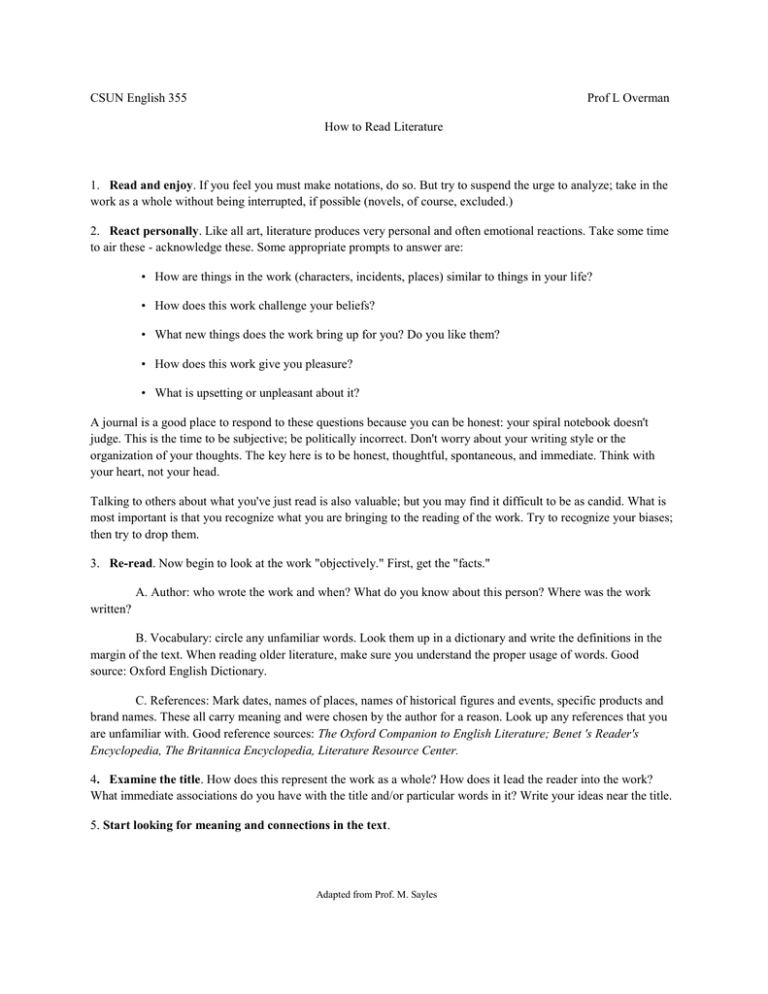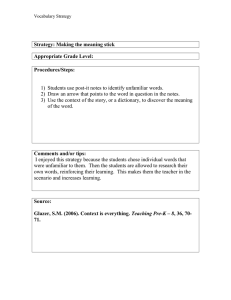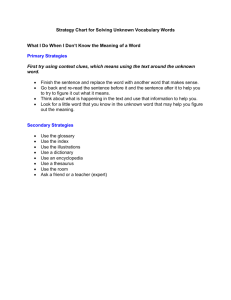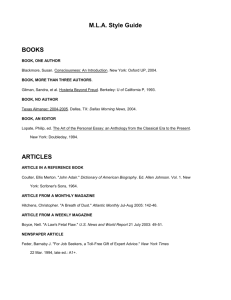How To Read Literature
advertisement

CSUN English 355 Prof L Overman How to Read Literature 1. Read and enjoy. If you feel you must make notations, do so. But try to suspend the urge to analyze; take in the work as a whole without being interrupted, if possible (novels, of course, excluded.) 2. React personally. Like all art, literature produces very personal and often emotional reactions. Take some time to air these - acknowledge these. Some appropriate prompts to answer are: • How are things in the work (characters, incidents, places) similar to things in your life? • How does this work challenge your beliefs? • What new things does the work bring up for you? Do you like them? • How does this work give you pleasure? • What is upsetting or unpleasant about it? A journal is a good place to respond to these questions because you can be honest: your spiral notebook doesn't judge. This is the time to be subjective; be politically incorrect. Don't worry about your writing style or the organization of your thoughts. The key here is to be honest, thoughtful, spontaneous, and immediate. Think with your heart, not your head. Talking to others about what you've just read is also valuable; but you may find it difficult to be as candid. What is most important is that you recognize what you are bringing to the reading of the work. Try to recognize your biases; then try to drop them. 3. Re-read. Now begin to look at the work "objectively." First, get the "facts." A. Author: who wrote the work and when? What do you know about this person? Where was the work written? B. Vocabulary: circle any unfamiliar words. Look them up in a dictionary and write the definitions in the margin of the text. When reading older literature, make sure you understand the proper usage of words. Good source: Oxford English Dictionary. C. References: Mark dates, names of places, names of historical figures and events, specific products and brand names. These all carry meaning and were chosen by the author for a reason. Look up any references that you are unfamiliar with. Good reference sources: The Oxford Companion to English Literature; Benet 's Reader's Encyclopedia, The Britannica Encyclopedia, Literature Resource Center. 4. Examine the title. How does this represent the work as a whole? How does it lead the reader into the work? What immediate associations do you have with the title and/or particular words in it? Write your ideas near the title. 5. Start looking for meaning and connections in the text. Adapted from Prof. M. Sayles A. Pay attention to how the author is using language. Is there anything unusual or purposeful in the author's choice of words? Where is the author using connotations or double meanings? Look at sentence structure, sound qualities, style, and dialects. Mark the text and comment where your notice language. B. Look for repetition - of words, phrases, names, images, and concepts. Mark them in a particular color. Does a pattern emerge? C. Examine the names of characters. Do they appear to be symbolic in any way? Are there common associations with these names? D. Underline sentences that strike you for some reason, either because of the content, the language used, or a visceral response it provoked. Can you see this relating to the whole in any way? 6. Put yourself into the action. If you are having a hard time "getting into" a text, i.e. you really don't like it or you can't understand it, read it again putting yourself into the action. Imagine that you actually inhabit the world of the work. Ask yourself, "What would my life be like in these circumstances?" This may allow you to better see the emotional, psychological, and historical elements of the work and may foster a better understanding. Adapted from Prof. M. Sayles





